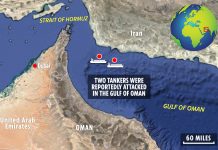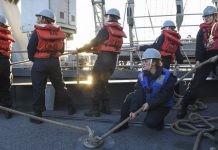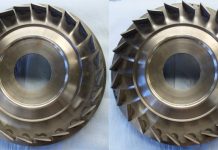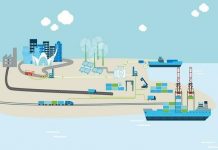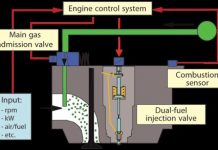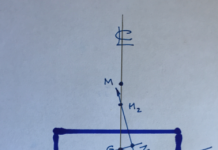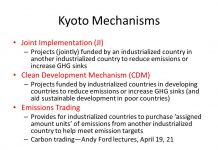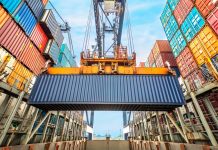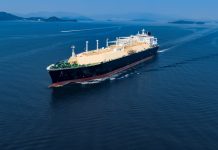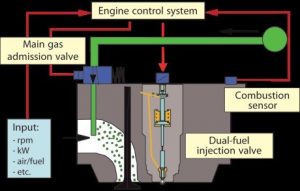In this process, a very small percentage of between 1 and 10% liquid heavy fuel or diesel oil is injected.
During the intake stroke, gas is admitted just before the inlet valves. The liquid fuel ignites the air/gas mixture.
The advantage is that the exhaust gases are cleaner than when heavy-fuel oil or diesel oil are combusted. Gaseous fuel contains fewer carbon atoms than a liquid fuel therefore reducing CO2 production. The emission of soot particles and the sulphur content are significantly reduced. Contamination of the engine decreases.
The dual-fuel principle
The dual-fuel engine principle. The diesel process is retained.
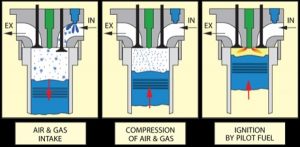
Left: induction stroke
As the piston moves downwards, a mixture of air and gas is drawn into the cylinder. The gas is injected in the inlet channel via a solenoid valve.
Middle: compression stroke
As the piston moves upwards, the mixture is compressed. The mixture is poor, which means that excess air volume is large (approximately 2). Due to this, the mixture does not ignite spontaneously.
Right:
Just before the top position of the piston, the fuel is injected into the cylinder under high pressure. This ignites immediately causing the air/gas mixture to ignite. Afterwards, the normal process takes place.
The dual-fuel system principle
The one fuel, gas, is admitted just before the inlet valves during the induction stroke. Gas and air are intensively mixed. The air factor is between 1.5 and 2.0. This is known as a ‘poor’ mixture. 50 to 100% more air volume is present than required to fully burn all the fuel chemically. At the end of the compression stroke, the very small amount of injected fuel ignites immediately followed by the rapid ignition of the air/gas mixture. The ‘Pilot’-injector replaces the traditional sparkplug. The process continues according to the diesel principle, which has a higher efficiency than the Otto-principle.
Methods of Introduction of Natural Gas into the Engine
Admit low pressure gas through gas admission valve when exhaust valve is closed and when pressure in the cylinder is low. Gas is compressed along with the air and the mixture is ignited by a pilot injector which inject small amount of fuel oil to the combustion space or using spark plugs (for small engines).
In the case of pilot injector, the injection of fuel oil into the combustion space result in ignition of fuel and thereby gas. The disadvantage of this method is that it produces knocking and comparatively less efficient.
Natural gas is compressed to around 250-300 bar, injected to the combustion space at the same time as that of pilot fuel injector. This method is found to be more efficient.
Working Modes of Dual Fuel Engines
There are basically 3 modes of operation for dual fuel marine engines used on-board ships.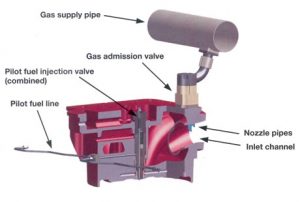
When engine is well supplied with natural gas, amount of pilot fuel injected is corresponding to 6% of the total engine load. In other words major contributor to the engine load is natural gas. When gas supply to the engine is constant and limited, then engine is said to be in “Specified Gas Mode”. Here gas supply is constant, but fuel oil quantity injected varies to meet changing engine load demand.
In “Fuel Oil Only” mode, gas supply will not be available, and engine runs only on fuel oil. This mode is used when engine is unstable, such as during restricted waters, heavy weather, manoeuvring, etc.
Features of Dual Fuel Engines
- Natural gas is compressed to about 250-300 bar using a number of compressors, working in series. Compressed gas is then cooled and led to valve blocks of each cylinder unit.
- Each valve block is fitted with an accumulator (it has a capacity to store about 20 times of the amount of gas injected to the unit at full load) for minimizing pressure drop during injection and to monitor pressure drop in case of any abnormality in the system (such as gas injection valve stuck open).
- The gas supply pipe lines are double walled. Compressed air is passed between the two walls (air seal), which is continuously monitored for any gas detection (gas is detected means leakage of gas).
- Outer wall of the gas pipe is made of stainless steel to withstand very low temperatures, in case of a leakage from inner pipe.
- Whenever the flow of compressed air between the gas supply pipe walls fail, the gas supply shut down and the line is purged with inert gas.
- For lubrication of parts and sealing of gas, gas injectors are supplied with sealing oil. (Sealing oil is pressurized to about 25-30 bar above gas injection pressure, and the sealing oil is injected and burnt along with the gas).
- Consumption of the sealing oil is very low, in the order of 0.13 g/kWh.
- The sealing oil system consist of two pumps for redundancy and a spring loaded accumulator to maintain the sealing oil pressure, since standby pump takes time to build up pressure when one pump fails.
- When a gas injection valve is stuck open (jammed), then gas pressure drops at the accumulator in the valve block, resulting in gas system shut down and pipe lines are purged with inert gas.
- If the pressure drop is not detected in the above case, then more gas burn, exhaust temperature rises. This results in gas supply shut down.
- In the case of late ignition while burning gas, there will be rapid pressure rise in the exhaust system. hence exhaust gas receiver is designed to withstand 15 bar pressure.
- Failure of pilot fuel oil system result in combustion failure of gas, then gas supply shut down and lines are purged with inert gas.
Disadvantages
- Knocking
- Availability of fuel
- Additional plant requirement
- Dual fuel engines perform best under moderate to high load, and can often equal or better the fuel-efficiency of a pure diesel under these conditions. Existing dual-fuel conversions suffer from major increases in carbon monoxide (CO) and hydrocarbon (HC) emissions and loss of fuel efficiency at light loads.
This is because they operate unthrottled, so that the air-fuel mixture becomes leaner as the load is reduced. As the mixture becomes leaner, combustion eventually degrades, leaving large amounts of partial reaction products in the exhaust.
IACS (International Association of Classification Societies)
- Require Following Safeties in Dual Fuel Engines
- Use oil fuel only while starting the engine.
- Use oil fuel only during unstable engine conditions, such as manoeuvring, restricted waters, etc.
- Engine should continue to run on fuel oil even when gas supply stops.
- Crankcase relief valves to be fitted in way of each crank throw.
- Construction and operation of pressure relief valve of engine units should consider gas leak inside the engine and subsequent pressure rise.
- Exhaust gas system of the engine to be independent and not to be mixed with any other systems.
- Starting air line to each unit to be fitted with flame arresters.
- Flame arrester to be fitted at the inlet of the gas supply valve to the units.
Apart from automatic shut down system, gas supply must be able to shut manually from engine starting platform or other control stations.





